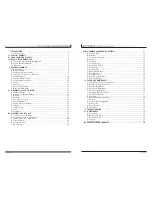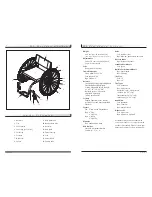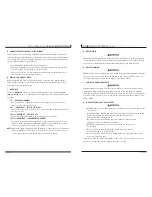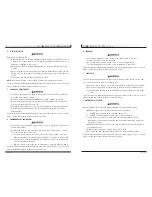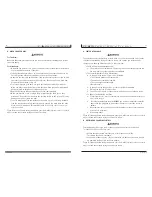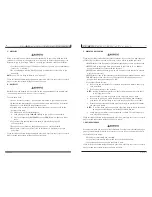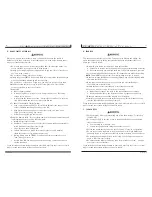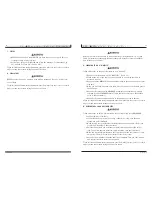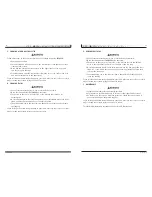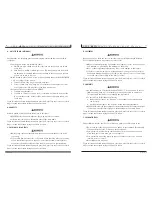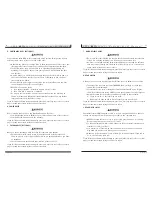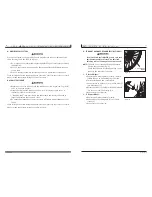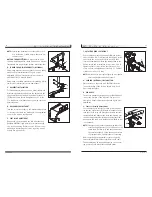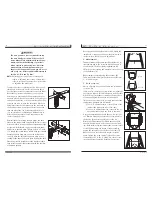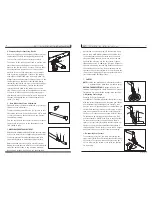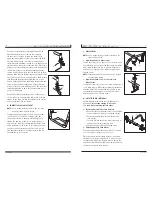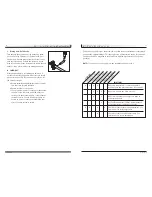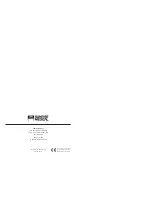
930487 Rev. B
I X . S e t - U p & A d j u s t m e n t
33
I X . S e t - U p & A d j u s t m e n t
930487 Rev. B
32
nut (B) down to the axle plug (C). Never allow a gap
greater than .800" (20mm) between the outside face
of the aluminum nut and the inside face of the axle
sleeve. Adjusting the axle sleeve out too far can dam-
age both the axle plug and the axle sleeve. Tighten
aluminum nut down to 200 in/lbs of torque. Repeat for
opposite side making sure the gap between the head of
the axle sleeve and the face of the aluminum nut are
the same on both sides (failure to do so will cause the
chair to track improperly). Place rear wheel axles back
into camber tube’s threaded sleeve.
J. CASTERS
NOTE–
Setting the wheelchair on a flat surface table or
a workbench helps make these procedures easier.
NOTE ON TORQUE SETTING–
A torque setting is the
optimum tightening which should be made on a particu-
lar fastener. Use proper torque settings when specified.
1. Adjusting Caster Angle
Checking for Caster Squareness:
Your Quickie Ti Titanium wheelchair leaves the factory
with the casters adjusted square. Any time you change
your wheelchair rear axle height (see Letter F), rear
tire size, center of gravity position or camber tube, you
should check that the casters are still square. A caster
that is not square will result in the caster lifting off
the floor as it rotates around the stem bolt (A). Check
for squareness by placing your wheelchair on a flat,
horizontal surface. Rotate both forks so that the cast-
ers are towards the rear of the wheelchair. Place a
square or pocket level (B) against the flat surface on
the rear of the fork and note whether this surface is
vertical (square). If this surface is more than 1 degree
away from vertical, your casters require re-squaring.
2. Re-squaring Your Casters
To re-square your casters, you must first remove the
right caster. (Note: Do not disassemble the left caster
at this time.) Loosen and remove the axle using two T-
25 Torx wrenches. Be certain to set aside the spacers
for reassembly.
4. Compensating for Seat Sling Tension
Before loosening any of the hardware that secures the
camber tube (See Rear Seat Height Adjustment and
Toe-in or Toe-out) follow the instructions below.
The tension in the seat sling will tend to pull the axle
plates inward when the hardware securing the axle
plates to the camber tube is loosened. To insure that
the axle plates are returned to the correct position,
mark the location of the axle plates on the camber
tube by placing a small strip of tape on the camber
tube next to the OUTSIDE edge of the axle plate. (A)
Always return the axle plates to these positions on the
camber tube when the chair is reassembled. During
reassembly, begin with one side of the chair and align
the axle plate with the tape. Tighten the hardware
securing the axle plate to the camber tune on this
side. Check for proper toe in/out adjustment according
to Section H-3. Next spread the axle plates apart so
that the axle plate on the opposite side is aligned with
the tape, and tighten the associated hardware to 65
in-lbs. (7.3 Nm).
5. Rear Wheel Axle Sleeve Adjustment
Tight axle sleeves should be maintained for proper per-
formance of the wheelchair.
To adjust the axle you will need a 3/4" wrench to turn
the outside axle nuts. You will also need a 1/2" wrench
to secure the axle on the ball-lock end, and prevent
the axle from turning.
Turn the outside axle nut counter clockwise to tighten.
There should only be zero to ten thousandths of an
inch (.010) of play.
I. WHEELBASE WIDTH ADJUSTMENT
Adjusting the wheelbase width allows the rider the option
to move the wheels closer or further away from the chair.
It also compensates for camber adjustment and gives
proper wheel spacing to maximize pushing efficiency.
Adjust threaded axle sleeve (A) to desired location,
making sure that the rear wheel does not interfere with
either the backrest tube or any mounting hardware.
Once desired location is achieved, run the aluminum
A
B
1° MAX
A
C
B
A

